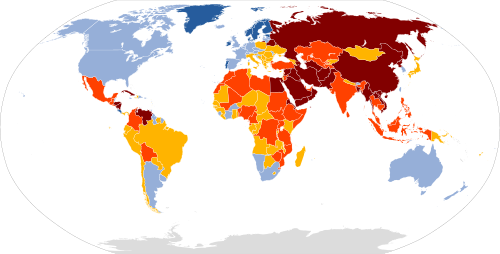國有媒體
(重新導向自国营广播)
| 此條目可參照英語維基百科相應條目來擴充。 |
| 新聞學 |
|---|
| 領域 |
| 類型 |
| 影響 |
| 媒體 |
| 角色 |
國有媒體(英語:State Media / State-Controlled Media / State-Owned Media),又稱國營媒體、官方媒體,是在財務和(或)編輯上被一個國家直接或間接控制的大眾媒體機構[1]。國有媒體可能是該國或該地區唯一的新聞獲取渠道,也有可能需要和其他商業或非商業的媒體機構競爭。需要注意的是,國有媒體不應該與那些由國家資助的公共媒體相混淆,後者是「由國家或地方政府資助卻不在編輯自由上受其嚴格控制」[1]。
概況簡介[編輯]
國有媒體大多分布在發展中國家、歐洲各國以及20世紀中後期的東方集團國家中,其運作所需資金完全由政府出資。其廣播內容則視各國政治情勢而定,特別在民主化程度較低的國家,主要為政治宣傳。除了對國內廣播之外,也會對國外通過國際廣播的形式播出。
經常與國有媒體混淆的概念為公共廣播。雖然部分國家的公共廣播機構由國家所有,但實際上為該公司獨立經營,政府並不干預其經營方針,如英國廣播公司(BBC)。
概念定義[編輯]
決定因素[編輯]
後果影響[編輯]
國有媒體很容易導致諸如新聞自由、新聞客觀性等複雜問題。根據《民主期刊》的克里斯托弗·沃克(Christopher Walker)的說法,「威權或極權國家的媒體」,例如:中國的中央電視台、俄羅斯的RT電視台、委內瑞拉的南方電視台都在利用本國內的新聞審查制度和對外廣播國家的民主開放制度的差異性獲得媒體優勢[2]。
國有媒體列表[編輯]
- 中華人民共和國:中央廣播電視總台(下轄中國中央電視台、中央人民廣播電台、中國國際廣播電台、中國環球電視網)
- 中華民國:中央廣播電臺(RTI)、警察廣播電台、漢聲廣播電台、漁業廣播電台
- 香港:香港電台(2020年前屬公共廣播性質,香港國安法頒布後逐漸成為國營廣播[3];同時負責在香港轉播部分中央廣播電視總台頻道/節目)
- 澳門:澳門廣播電視股份有限公司(2020年前葡文新聞部仍屬公共廣播性質,此後逐漸成為國營廣播[4][5];同時負責在澳門轉播部分中央廣播電視總台頻道/節目)
- 美利堅合眾國(美國):美國國際媒體署(USAGM)下屬所有媒體(包括美國之音、自由亞洲電台等)、美國軍中廣播(AFN)
- 俄羅斯聯邦:RTR、RT電視台、衛星廣播電台
- 法蘭西共和國(法國):法國世界媒體(包括法蘭西24、法國國際廣播電台、蒙特卡洛中東電台、法國國際電視台、France Info)
- 大韓民國:KTV國民放送、國防FM
- 朝鮮民主主義人民共和國:朝鮮中央電視台、朝鮮中央廣播電台、平壤廣播電台、朝鮮之聲
- 越南社會主義共和國(越南):越南之聲、越南電視台
- 蒙古國:蒙古之聲
- 泰王國:泰國廣播電台
- 白俄羅斯:白羅斯國家通訊社
新聞自由[編輯]
民權及政治權利[編輯]
經濟權[編輯]
相關條目[編輯]
參考資料[編輯]
腳註[編輯]
- ^ 1.0 1.1 Webster, David. Building Free and Independent Media. Air War College Media Relations (美國空軍). 1992-08 [2020-08-08]. (原始內容存檔於2004-03-15).
- ^ Christopher Walker. The Authoritarian Threat: The Hijacking of “Soft Power”. 民主期刊. 2016-01, 27 (1): 49–63 [2020-08-08]. (原始內容存檔於2020-09-22).
- ^ 從社會公器到官方「喉舌」:香港電台「改頭換面」. 紐約時報中文網. 2021-11-16 [2021-11-20]. (原始內容存檔於2021-11-20).
- ^ TDM葡文部傳被整肅 中文記者痛心:澳門一大損失. Plataforma. 2021-03-21 [2022-03-17]. (原始內容存檔於2021-12-12).
- ^ 澳廣視記者被告知勿報導違反中央政府政策的信息. Plataforma. 2021-03-11 [2022-03-17]. (原始內容存檔於2021-12-12).
- ^ 2022 World Press Freedom Index. Reporters Without Borders. 2022 [2020-08-08]. (原始內容存檔於2020-10-03).
文獻[編輯]
- Beck, Thorsten; Demirguc-Kunt, Asli & Levine, Ross. A New Database on Financial Development and Structure. Policy Research Working paper 2146, World Bank Washington D.C., 1999.
- Djankov, Simeon. Who owns the media? World Bank Publications, 2002. ISBN 978-0-7060-4285-6.
- Djankov, Simeon; La Porta, Rafael; Lopez-de-Silanes & Shleifer, Andrei. Regulation of Entry(頁面存檔備份,存於網際網路檔案館). The Quarterly of Economics, 117(1), pp. 1–37. 2002.
- Djankov, Simeon; McLeish, Caralee; Nenova, Tatiana & Shleifer, Andrei. Who owns the media?(頁面存檔備份,存於網際網路檔案館) Journal of Law and Economics, 46, pp. 341–381, 2003.
- Hoffmann, Bert. The politics of the Internet in Third World development: challenges in contrasting regimes with case studies of Costa Rica and Cuba. Routledge, 2004. ISBN 978-0-415-94959-0.
- Hoffmann-Riem, Wolfgang. Regulating Media: The Licensing and Supervision of Broadcasting in Six Countries. Guilford Press, 1996. ISBN 978-1-57230-029-3,
- Islam, Roumeen; Djankov, Simeon & McLiesh, Caralee. The right to tell: the role of mass media in economic development. World Bank Publications, 2002. ISBN 978-0-8213-5203-8.
- Karatnycky, Adrian; Motyl, Alexander; Schnetzer, Amanda; Freedom House. Nations in transit, 2001: civil society, democracy, and markets in East Central Europe and the newly independent states. Transaction Publishers, 2001. ISBN 978-0-7658-0897-4.
- La Porta, Rafael; Lopez-de-Silanes, Shleifer, Andrei & Vishny, Robert. Legal Determinants of External Finance. Journal of Finance, 52(3), 1131–1150, 1997.
- Lewis, Arthur. The Theory of Economic Growth. Routledge, 2003 (originally published 1955). ISBN 978-0-415-31301-8.
- Myrdal, Gunnar. The Political Element in the Development of Economic Theory. Transaction Publishers, 1990 (originally published 1953). ISBN 978-0-88738-827-9.
- Price, Monroe. Media and Sovereignty: The Global Information Revolution and Its Challenge to State Power. MIT Press, 2004. ISBN 978-0-262-66186-7.
- Price, Monroe; Rozumilowicz, Beata & Verhulst, Stefaan. Media reform: democratizing the media, democratizing the state. Routledge, 2002. ISBN 978-0-415-24353-7.
- Sen, Krishna; Lee, Terence. Political regimes and the media in Asia. Routledge, 2008. ISBN 978-0-415-40297-2.
- Simon, Joel. Hot on the Money Trail. Columbia Journalism Review, 37(1), pp. 13–22, 1998.
- Silverbatt, Art; Zlobin, Nikolai. International communications: a media literacy approach. M.E. Sharpe, 2004. ISBN 978-0-7656-0975-5.
- Stability Pact Anti-Corruption Initiative, Organisation for Economic Co-operation and Development. Anti-corruption measures in South Eastern Europe: civil society's involvement. OECD Publishing, 2002. ISBN 978-92-64-19746-6.

